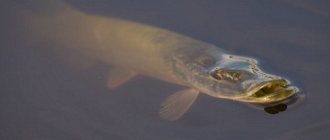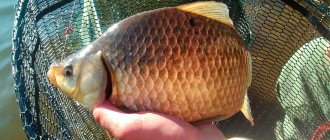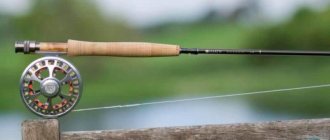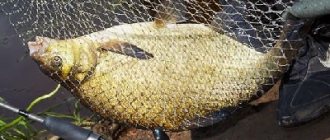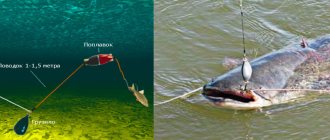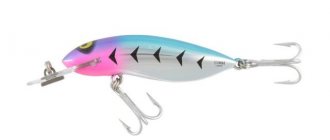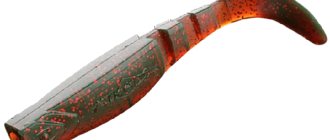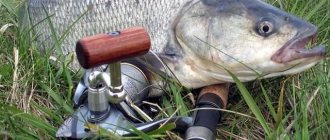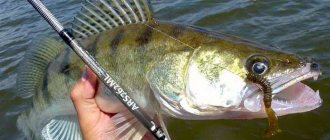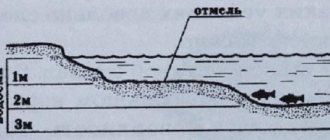Behavior of fish in troubled waters
Any rise in water in a reservoir leads to cloudiness. This usually happens because the current erodes the banks, from which most of the dirt comes. In spring, the water also becomes cloudy due to the melting of ice and snow. In such conditions, underwater inhabitants become uncomfortable - a large amount of turbid suspension forms in the water column, which clogs the fish’s gills, and it tries to move to areas with cleaner water. In addition, the current in rivers noticeably increases, which also leads to the migration of fish from the main channel to shallower areas with slower flows. In such places, the fish do not have to spend a lot of energy.
The behavior of the fish also changes. Pike and pike perch rely more on vision; in poor visibility conditions they have to change their hunting tactics - look for places with a large concentration of juvenile fish. Peaceful fish species, such as bream, roach, crucian carp, and carp, rely more on their sense of smell, so poor visibility is not as critical for them as for predators.
Where does a pike stand in troubled water?
A pike in muddy water tries to occupy a place in order to somehow protect itself from the dirt suspended in the water. Pike does not stand near the shore and does not stand in the current; it chooses areas with low pressure that form behind underwater obstacles.
Or the predator chooses areas on the border between forward and reverse flows. Fishermen can often see that between two jets, forward and backward, a so-called “eye” is often formed - an oval area of relatively clear water.
At these moments, the pike tries not to move unnecessarily. You will not see such movements as the predator sometimes makes in clear autumn water or in clear water before high water. First of all, the fish is worth it. And secondly, the water is so cloudy that you can’t see anything!
Pike attacks at this moment are short. The predator attacks no further than the length of its body. However, at this moment the white fish also tries to stay in the same places that the predator chooses for itself.
And this means that the pike has absolutely no need to make long movements, because the food fish is constantly scurrying in front of its very nose.
Where to look for fish on the river and in still water
Fish, as a rule, do not stay in one place for a long time, so to catch it you need to run a lot. On large rivers, as the water level rises, the relief is difficult to read, but promising places can still be identified. Such places are:
- River bend.
- Confluences of streams or small rivers.
- Water meadows.
- Places with little current.
- Places located below the dam.
In reservoirs with stagnant water there are no problems with the flow, as well as with finding fish. The most promising places on reservoirs are the mouths of tributaries, places with shallow depths, snags and various bottom vegetation.
Fishing methods
Fishing in muddy water on a river in the spring has its advantages - the fish does not see a person and relies on its lateral line and sense of smell. She behaves less carefully than in clear water. Therefore, the thickness of the fishing line and the size of the hook play a small role. Before the water level rises, it is good to fish with a float rod. At this time, the fish stays close to the shore, where there is no current. With the onset of the flood, it is better to switch to bottom gear (feeder, regular bottom) - they allow you to fish in places where you can no longer reach with a float rod.
On the eve of spawning, many representatives of the carp family - roach, bream, ide - work up a good appetite and feed actively. Fish gather in large schools and enter small rivers or channels, moving upstream to their spawning grounds
On large rivers, as the water level rises, the current intensifies and fishing on the riverbed becomes extremely difficult. It even carries loads weighing 120–150 g without much difficulty. In addition, fish leave the riverbed because, along with melt water, the stream carries with it an abundance of various debris. Water with a strong current is the dirtiest in the entire river. The fish tries to stay in areas of the reservoir with a slow current. It is better to fish near steep banks, in pools, in places with reverse flows, at the confluence of small rivers.
Various animal baits are used as bait - worms, maggots, bloodworms, bark beetle larvae. Vegetable baits are not popular with fish at this time of year.
Large fish are well caught on crawlers, which are not difficult to catch at this time
Bait must be used carefully, as during this period it is very easy to overfeed the fish. On small rivers, during the spring fish run, you can do without it. But if the fish path is a little to the side, then a small amount of bait can attract a school to the fishing point.
Feeding with mixtures consisting only of plant components is an unpromising activity. The bait must include animal components - bloodworms, maggots, worms. If there is a current, you should add a little earth to the bait.
SPRING WIRING IN MUDDY WATER
Open water fishing has started earlier than ever this year. If on small lakes there is still ice, or rather, it covers the water surface, then on all rivers and streams it has long been gone.
One of the peculiarities of the water regime on the rivers this year is that the ice melted very quickly, the rise in water level from the melted snow is very insignificant. Now the process of melting snow in the forests is still ongoing. Not only melt water flows into the rivers, but also groundwater, since the ground has not completely thawed. This leads to the fact that, despite the weak flood, the water in the rivers is cloudy and will remain cloudy until the ground thaws completely. Strictly speaking, this process on some rivers can last another two, or even three weeks. Where the water in the river is sufficiently clear, fishing gradually turns into summer fishing, of course, taking into account the characteristics of the pre-spawning behavior of the fish. But today we’re talking about fishing in troubled waters. It is characterized by the fact that, firstly, it is coastal, and, secondly, that it is carried out in conditions of limited space between branches and vegetation. Fishing with a “summer” jig using a fishing rod with a nod is promising. The bait drops to any chosen fishing point without any difficulty. Fishing is complicated by the presence of bushes and trees, and it is here, among the flooded bushes, in creeks and creeks, that the water settles and becomes clear faster. All the fish rush to this clear water. Despite the fact that the summer jig as a tackle is very convenient, it does not always allow for effective fishing. The reason is its relative "roughness". Often, fishing conditions predetermine the use of very large jigs in order to compensate for the effect of a strong current. If a large fish bites on a large bait, then a summer jig may be out of competition. This type of tackle is very effective when fishing in nooks and crannies without a current, when you can use the smallest and lightest jig. If fishing conditions require you to present a small bait to the fish in a fairly strong current, it makes sense to use either a fly rod or a pole. Unlike a jig, in a float rod rig most of the mass is concentrated in the weight and not in the bait. It turns out that if you are going to a specific body of water, then you should think and weigh what gear to take with you. Either a jig, or a plug, or maybe a fly rod with equipment for fishing with a half-bottom. The correct choice of fishing location depends solely on the experience of the fisherman. Here we can give only a few comments about the usual behavior of fish. During the spring movement along the river, the bulk of the fish sticks to the edge of the vegetation and the first bank edge, while periodically entering places where there is no current. Some of the fish from the river enter the channels that connect the river with the lakes, but large fish do not enter the lakes that are “dead” in the summer. First of all, pike, roach, ide, silver bream, catfish, and bleak rush into the flooded channels. There is no point in catching them here in the highest water, since the water is still very muddy. As the water clears and begins to drain, fishing becomes very interesting. Of greatest interest are the mouths of channels and underwater depressions opening into river bays. The fish almost never goes to the flooded shore, but sticks only to those places where there will be water left after the flood. Most likely, this behavior is associated with the instinct of self-preservation. In general, during any water release, the fish immediately leaves shallow places and goes into the depths. The most favorable conditions for fishing occur when the rate of drop in water level slows down and sometimes even becomes zero. That is, after night frosts, the flow of melt water decreases, and when the sun warms the ground, the flow of water resumes and for several hours, usually from lunch, the water level remains unchanged. That is why, after night frosts, the best time for fishing should be late morning and lunch. Promising places to find roach and bream are deep coastal areas. There may be no current at all and the roach can reach the very shore. I often fish in such places with a rod only a meter long, right under the shore. Good fishing also happens in places where water has flooded a low bank and a bay has formed, but without any depressions at the bottom. Here the fish periodically comes out to the upper edge of the summer shoreline. In all cases, you need to look for either a small depression at the bottom, or some kind of obstacle, or the boundary of quiet and flowing water. The fishing depth is often only twenty centimeters. After choosing a place, the necessary gear is prepared. The main thing is the selection of equipment, which we talked about a week ago. The equipment should be minimal in weight, with the simplest load distribution and sufficient strength in difficult fishing conditions and taking into account the likelihood of catching a large trophy. Typically, the technique for fishing in muddy water is to hold the bait at the fishing point. To do this, you can either place the bait on the hook of a summer jig, or hold the equipment with a plug at the fishing point, or resort to the help of the well-known tackle - “half-bottom”. The choice of bait is very important. If you are going to catch roach, ide, chub, silver bream, bream or crucian carp, then a worm will almost certainly be the best bait. There is subtlety. In the summer, when catching large fish, it is advisable to use not just a whole worm, but a bunch of three or four worms. In the spring, it makes sense to use a whole worm only when fishing for the same bream, fairly large ide, crucian carp or chub. For large roaches, roaches or dace in the spring it is much more effective to use a piece of worm. There are two reasons for this. Firstly, the fish now has caviar and it’s difficult to get a large “piece” into your mouth. Secondly, a piece of worm gives off such a pungent odor that even the smell of bait pales in comparison. There is a fairly rare case when bait is also groundbait. Other baits include caddisflies, which are now very abundant in flowing water bodies, as well as large bloodworms, which flood water intensively washes out of silted areas. Large maggots are very good. A special question about bait. On the one hand, I believe that bait can nullify the beginning of the bite, but on the other hand, it can be absolutely necessary. The essence of this contradiction is very simple. The fact is that if you use bait thoughtlessly, it will most likely lead to a negative effect. Simply throwing bait at the fishing point without taking into account the direction of the bottom current means risking displacing the fish from the fishing point. Feeding correctly is now very difficult, for this you need to have a lot of experience. If you are not confident in your experience, then it is better not to feed. If feeding, I definitely recommend using domestic groundbait for cold water. Under no circumstances should you feed the chosen fishing spot with standard “summer” balls the size of an orange. You need to prepare a small amount of bait, bring it to the required consistency and do not rush to throw it into the water. When fishing near the shore, it is best to mix the bait with the ground and lower it to the fishing point, then move away from the shore for camouflage purposes. Only after the point where the fish are biting has been found and several roaches have been caught, then perhaps it makes sense to try bait. Although in each case you need to weigh whether it is worth doing. Bait is now unlikely to attract fish to the fishing point; you can only activate it. However, any mistake in feeding will inevitably lead to the cessation of biting. The most common scenario is the following. The fisherman changes his fishing spot every ten minutes, and when he finds a “cool” place, he settles in, throws in one or two small balls of bait and fishes throughout the day.
Catching predatory fish
Before the spawning ban begins, you can catch not only peaceful fish, but also predators - pike, perch, pike perch. Fishing at this time is quite unpredictable and you can often end up with nothing. The bait must be given literally under the fish's nose, otherwise it will not react to the prey.
In troubled waters, predatory fish should be looked for in the same places as peaceful fish. A promising place needs to be fished carefully, making a large number of casts; often the result is achieved by changing the bait. The wiring should be as slow and delicate as possible. You can use any type of spinning bait:
Silicone baits. The weight of the jig head should be as small as possible (2–5 g), despite the increasing strength of the current. It is the smooth lowering of the bait to the bottom that attracts a passive spring predator. If the current is weak, then you don’t have to surround the silicone bait at all.
Spoons. Large oscillating and spinning lures are great for fishing in muddy water. At this time, they are the most effective baits, along with silicone.
Mepps Aglia Long is one of the best baits for catching predators in muddy spring water
Wobblers. Wobblers with active play and sound effects give good results. Mostly cranks and shads work. Sometimes minnows are also fired, but the wiring must be done smoothly and slowly, with pauses of 10 seconds.
Along with spinning baits, it is also effective to catch predators using live bait. A small roach or gudgeon is suitable as bait.
As you know, pike perch and pike rely more on vision than on smell, so in turbid water conditions they should be caught with brightly colored lures. Both acidic colors - red, yellow, orange - and less bright but contrasting ones - black, white work well.
“If there are no bites, it is useful to change the type of bait, for example, change a twister to a vibrotail.”
What to use to catch pike in troubled water?
All of the above factors tell you what to use to catch pike in troubled waters, what baits to offer to the predator and how to lead them so that the bite takes place.
In muddy water, any noise lure or lure with active action but slow retrieve will work.
Noise wobblers are what you need for muddy water.
Here are the factors that must be met in order for a predator to attack the bait:
- The bait must make maximum noise and have a wide amplitude of action in order to be noticed by a predator on the approach. Crank wobblers, spinners like Aglia and Komet, and spinners with active play will work best.
- The bait should fall directly into the predator's parking area. Any other wiring away from the parking lot will be ineffective. That is, you will have to practically “lick” the bait with underwater mounds, blocks, snags and flooded trees at the bottom.
- The bait must move slowly so that the predator can attack the bait when it is directly near him. No active wiring - only slow wiring with pauses and stops. When fishing with spoons, it is sometimes useful to let the spoon “sink” to the very bottom.
Follow these three requirements and even in troubled water you will be able to catch your pike.
Slowly retrieving a large spooner near the very nose of a predator can provoke the pike at this moment.
More on this topic on our website:
- Pike fly fishing - where and when to catch To check how pike is caught by fly fishing, you don’t have to wait for the end of the spawning ban. For this fishing, a small body of water, remote from…
- Popular jig baits for pike What to use to catch pike? This predator will bite on any bait, even those that are not bait at all...
- The most catchy lures for pike in the grass - TOP 5 lures To effectively catch a predator in a body of water, you need three things - the angler must know where to look for pike, the angler must be able to catch...
- Pike in the spring for spinning - choose the time, place and bait After the ice has melted from the river beds, you can begin the spinning season in open water. There are many places in Russia where…
On the jig
In the spring off-season, a fishing rod with a side nod is a good alternative to float and bottom tackle. Often, fish in troubled water come close to the shore and it is even easier to catch them with a jig than with a float or feeder. The oscillations of the jig in conditions of low transparency are more noticeable to the fish than the bait lying motionless on the bottom. You can catch any white fish with a jig - roach, white bream, silver bream, crucian carp, and often perch is also caught.
Lightweight carbon-fiber rods with a length of 5 m or more are ideal for side-nod fishing. They are equipped with either a regular reel or a small wire reel. The weight of the entire set plays a primary role, since you have to constantly keep the tackle suspended and play with it. Longer nods are used than for ice fishing. Jigs also have more impressive sizes, but their shape remains the same:
- Devils.
- The pellets.
- Uralki.
- Nymphs.
First of all, you should fish coastal thickets, snags, bushes hanging over the water, and backwaters with a reverse current. Although there are bites on a naked jig, there are fewer of them than on a baited jig.
Standard animal baits are used as bait:
- Worm.
- Maggot.
- Bloodworm.
“In the spring, you need to fish only with bait of animal origin; the fish ignores plant baits.”
You need to approach the fishing spot as quietly as possible - although the fish in muddy water cannot see the fisherman, they can hear sounds perfectly. Stomping and loud conversations can alert underwater inhabitants
Spring fishing in high water
Fishing during the spring flood period can be divided into two stages. Early fishing in the spring begins with the intense melting of snow, which leads to a noticeable increase in water and ice breaking away from the shores of closed reservoirs.
Late spring floods are characterized by the absence of snow in open areas, although in thickets of forests islands of unmelted snow can be found until the end of May.
In rivers the ice has long disappeared, but in stagnant bodies of water - lakes, ponds, oxbow lakes - the thick ice cover can last until the spring May holidays. Fishing in the spring on a lake or river oxbow from ice cut off from the shore can bring very good fishing results.
Large flood waters, naturally, should somehow affect the behavior of the fish and, as a result, the result of spring fishing. But an even greater influence is exerted by turbidity, which in a lake, oxbow lake or pond settles near the shore, and in the course of the river rushes along the flowing reservoir to the mouth.
Fishing in muddy flood waters
I think it is no secret to any of the fishermen that fishing in the muddy waters of the spring flood a priori cannot be crowned with success for at least two reasons.
The smallest particles of debris clog the channels in the fish's gills, which are responsible for the supply of oxygen, and it begins to suffocate. In the spring, fish in the muddy water of a flooded river no longer see the baits on the hooks of fishermen’s gear.
Therefore, schools of fish in rivers rest in areas with weak or no current, where less turbidity is concentrated in the water. Usually these are backwaters, bays, areas around a bend in the river or a cape, where the fisherman must decide on a fishing spot in the flood of a spring reservoir using the available gear.
The influence of water profit on the prospects of fishing
The prospects for fishing during the spring flood are more than noticeably influenced by fluctuations in the water level in the reservoir, the profit of which largely depends on the warming of the air and the presence of rains, which literally wash away snow and ice.
And at the same time, the spring surplus of water creates new food pastures for fish from uneaten food along the banks of small rivers, oxbow lakes, lakes, and ponds, where you can find many places with melted, but clean water without turbidity for promising spring fishing.
Safe fishing on the lake in spring
Starting from the second half of April, safe fishing is guaranteed only from the shore of a lake or an oxbow river, but during my foolish youth three times I had the opportunity to actively participate in spring ice fishing at the height of the flood, albeit with the safety net of a rubber boat.
All cases occurred during the spring May holidays. They came to fish in the expanses of a small river that overflowed during the flood, but due to the impossibility of catching fish there, they immediately moved to a fairly large lake located nearby, where the fish that had come from the river at one time took root.
The result of the last such spring fishing: floundering in the ice slush, although relatively close to the shore of the lake, a copious libation on the occasion of salvation on the day of the national holiday and the early return of a wet hedgehog in the fog to his beloved family. And somehow managed not to lose his inflatable Swift.
Nowadays, that is, many years after the incident described above, during the spring flood period I usually take a short vacation at my own expense. And taking into account the May holidays, I have time to go fishing where I planned - on lakes, oxbow lakes and rivers.
I fish either from the shore or from a small boat with side rods with different equipment, fishing with which during spring floods has its own specifics or features. Below I will describe how I fish during spring fishing inside and at the outlet of the oxbow lake of the small river.
Burbot fishing
Techniques for catching crucian carp in spring (video)
In early to mid-April, the ice breaks up on the rivers and an interesting period of open water burbot fishing begins. In muddy water, burbot is more active and it is best to catch it during this period of time using donks and baits. If in the fall it bites mainly at night, then in the spring it can be caught throughout the day. But the main thing here is to choose a suitable place, otherwise you may not get any bites. Good places at this time:
- Braids.
- Coastal dumps.
The simplest tackle for catching burbot is a hook. It is a piece of thick fishing line (0.5–0.6 mm) with a retractable leash, a hook and a flat sinker at the end. The length of the fishing line is selected for the specific fishing location, but, as a rule, 20 meters or less is enough. In general, the thickness of the fishing line does not affect the number of bites in any way - you can use very coarse tackle and always have a catch. Animal bait is placed on the hook:
- A bunch of worms crawling out.
- Live bait (minnow, ruff).
- Chicken giblets.
The tackle is thrown into the intended stopping place of the burbot. The fishing line is attached to a wooden peg stuck into the bank.
To detect a bite, hang a bell on the line
Burbot, as a rule, is spotted on its own, and such gear does not require constant presence from the angler. Therefore, the number of tricks can be quite large - 10 pieces is not uncommon.
A few words about color and contrast
There is, however, also such a thing as bait contrast. I don’t have a clear solution here. On the one hand, I caught pike perch well even with gray foam rubber. On the other hand, purely intuitively, it seems to me that a bright bait should be more noticeable in muddy water. Bright orange, for example. And, at the same time, I understand that it is in muddy water that a dark bait should be more noticeable - if only because it reflects less light, i.e. absorbs it. And around the suspension in the water, on the contrary, daylight is scattered.
Thus, I decided for myself that a dark bait has a greater chance of being noticed by pike perch. These are my own black foam “fishes”. For “silicone” I also try to follow the rule I introduced. Of the silicone baits I use, I can mention the Motor Oil the Mottomo and Berkley brands . By the way, Berkley also has a frankly black Black colorway. I am sure that many manufacturers of soft baits have dark colors - I would choose them first of all when fishing in muddy water in the spring.
Catching bleak
In early spring it is interesting to catch bleak. Although this fish is not large in size, it is very tasty when dried and in spring it is especially fatty. To catch it, no special gear is required; a regular Bolognese or fly fishing rod will do. You need to hang the equipment on it:
- Line with a diameter of 0.12-0.14 mm. You can use a thicker one, but thin lines flutter less in the wind.
- Lightweight float with a load of up to 1 g. The smaller the load of the float, the better - bites from such a small fish as bleak will be more noticeable.
- Loaded pellets.
- Leash with a diameter of 0.08-0.11 mm.
- Hook size 16–20, according to international numbering.
It is necessary to fish with bait. It allows you to attract fish from long distances. But unlike other white fish, bleak is not demanding on the composition of the bait, so you can use any purchased mixture - for bream, raft, carp. The main thing is that the bait has a strong smell. A prerequisite is that the bait should be crumbly, easily disintegrate in the water and create a cloudy cloud of particles, and it should not fall like a stone to the bottom. You need to feed often and in small portions, i.e. the lumps of bait should be the size of a walnut.
Bleak is shy and may not come to the bait right away - you need to take this into account during the fishing process
To obtain additional suspension, it is useful to add dry milk to the bait or mix the mixture not with water, but with diluted kefir.
The best bait for this time is maggot. Due to its density, it is more difficult for bleak to pull it off the hook.
Bleak lives in the middle and upper layers of water; catching it at the bottom is a futile task. The float should be lowered in the area of 0.5–1 m.
“When the bite is capricious, it is useful to slightly increase the descent of the float and raise the sinker up. A hook with a nozzle will sink more slowly and, as a rule, this technique provokes a bite.”
Fishing techniques from the shore and boat
Typically, spring fishing occurs when there is muddy water. At this time, the fish stops relying on its vision to obtain food. For this reason, surface baits do not attract grayling well enough.
This fish is able to see a person if he is visible from the water against the sky. To remain unnoticed, you need to be quiet and bend down.
In May it is caught during the daytime. The weather does not have a significant effect on the bite, but if it is sunny, it will be a little better.
Fishing from a boat has its advantages:
- There is sufficient freedom to choose a fishing spot.
- The process itself is more dynamic, giving you the opportunity to try different bait options.
- Casting a spinning rod and retrieving the tackle takes much less time compared to fishing from the shore.
- You can fish from a boat by casting a spinning rod in different directions.
- It is much easier to land caught fish, since snags and vegetation do not interfere, which often happens when fishing on the shore.
However, this method also has disadvantages. The main one is fatigue from being on a boat for a long time. In addition, during waves or strong winds, it is difficult to stay in the same place for a long time.
It is recommended to look closely for splashes on the water. It is advisable to stop the boat at a distance of 3-4 m from them. It is recommended to attach the sinker at a short distance from the float. In this case, the bait will be in the upper layers of the water. Grayling rarely dives into the depths to feed.
When casting a float tackle, you need the float to fall with minimal noise. A float made in the shape of a cone is suitable for this purpose. Having grabbed the bait, the grayling will pull it down. At this moment there is no need to hook him yet. You need to give him time to swallow the bait. You need to wait until he appears from the water. In order not to upset the balance of the boat, you need to hook before hooking. Raise the spinning rod as high as possible to perform the movement without jerking.
Fishing for grayling from a boat in March:
Wiring methods
If you are using a dry fly, the most effective way is to move it with the current, imitating an insect that has fallen into the water. When using bait that imitates live bait, the retrieve should be done across the current, imitating the natural behavior of the fry. This must be done in the water column or at the very bottom.
Various wiring methods can be used:
- One of the most effective is the use of stepped wiring. At the same time, there is a constant change of pace or stop. Sometimes you need to perform accelerated rewinding on a short section.
- The use of uniform wiring is common. In this case, the reel is wound at the same speed, sometimes taking short breaks. It is necessary to do the wiring slowly, gradually choosing the fishing line. It is recommended that the bait is constantly located at the surface of the water. After the bait imitating a wounded fish has moved a few meters, it must stop. Then continue moving.
- Sometimes the behavior of the fry is imitated. In this case, the bait is deepened so that it floats a short distance at the bottom. Then they bring it to the surface, simulating an insect hunt. Then it is again lowered to depth.
Grayling is a strong fish, so when pulling it out of the water, you should not loosen the line.
Fishing for crucian carp in the river
As the water rises, crucian carp also enter the river. Moreover, crucian carp is large; fishermen often trophy fish weighing more than 1 kilogram. You need to look for it in creeks, with snags and bushes. The depth at the fishing site is often shallow - up to 3 m, the water here warms up the fastest, and as you know, crucian carp is a heat-loving fish.
They catch crucian carp with a regular float rod without using bait. Given the large size of the fish, thin summer rigs are not recommended. After hooking, the crucian carp tries to go into the snags and often you have to force the landing, but this cannot be done with a thin fishing line.
The bait is a dung worm. You can also use a regular worm, but a dung worm has a stronger smell and is more noticeable to fish in turbid water conditions.
To catch crucian carp in the river, it is better to use a float rod rather than a bottom one.
Tips for fishing in troubled waters
- Avoid places with strong currents - catching fish here during the peak of the flood will be problematic.
- The best places for fishing in muddy water are small rivers and stream mouths. The water here is cleaner than on large rivers.
- When catching a predator using a spinning rod, use bright, contrasting baits. They are more noticeable to fish than lures of natural colors.
- When catching bleak, use bait. It will attract fish from long distances and keep them in place.
- If there are no bites, then do not sit in one place - in the spring the fish actively move around the water area of the reservoir. This rule does not apply to catching predatory fish. In this case, you need to fish each place as carefully as possible.
- The worse the weather (rain, strong wind), the better the burbot bite.
- To catch white fish, use bait of animal origin. At this time of year, the bite on them is better than on plant baits.
- In the spring, the most catchy baits for catching predators are spoons (oscillating and rotating) and jig baits.
Fishing in murky water conditions is not the easiest. Unpredictable bite due to constantly changing water levels makes such fishing less interesting than in other periods. But by following certain principles, you can still have a stable catch.
Fishing in muddy water after a flood
Mid-May, early June, time of active search for food for many spawning fish. But spring waters and runoff form strong turbidity in reservoirs. In more than 50% of cases, the fish simply does not notice the bait attached to the hook, even when in close proximity. Accordingly, the fisherman gets the false impression that there is no bite as such or no fish in general.
However, fishing in muddy water can be quite effective and can yield an excellent catch if you take into account a number of features and recommendations:
- Fish, especially large ones, are less careful compared to the period of light water. Muddy water makes the presence of the fisherman on the shore less noticeable.
- The main emphasis should be on odorous baits, since vision, due to cloudy water, does not give the fish the desired result in searching for food. It is recommended to use fragrant bait, proven flavors and attractants. When choosing baits, you need to focus on their color - light and white tones visually stand out against the background of muddy water. The metallic shine will also not go unnoticed by the fish and can attract its attention from a distance. For this purpose, one or two small shiny beads or beads are placed on the hook or in the immediate vicinity of its eye. Their goal is to attract the attention of fish from a distance and force them to approach the bait.
- Much attention should be paid to the choice of location. In strong currents, as well as in places where streams of melt water flow into the reservoir, the turbidity is highest. On the contrary, in places with a quiet current, all kinds of creeks and backwaters have lighter water, since turbidity in such places quickly settles.
- You should not let the nozzle lie on the bottom for a long time, even if no one touched it the entire time. The settling turbidity lies on it and covers it with a layer of sediment, which finally makes the bait inaccessible to fish. In general, any movement of the bait under water - dragging along the bottom, twitching, playing in mid-water, flicking, etc. - immediately attracts the attention of the fish and provokes a bite.
- Excellent results, especially during the spring fishing period in troubled waters, are obtained by fishing with a jig from a boat. The principle of fishing and tackle (winter fishing rod) are similar to winter fishing. Having chosen a fishing spot in advance and fed it, the fisherman sets the boat in such a way that it remains in a strictly stationary position. During fishing, jig play, retrieving and other winter fishing techniques are performed more actively. But the most important thing is to ensure increased caution when moving in a boat. The angler fishes vertically, using the action of a jig - the fish that is actually under the boat or in the immediate vicinity. Excessive knocking on the sides, squelching from the bottom of the boat will inevitably scare it away, especially large specimens.
Read! Features of choosing bait for fishing
In general, in order to always fish successfully, you need to learn and adapt to the conditions, and then even muddy water after floods will not become an obstacle to fishing.
